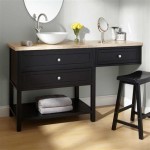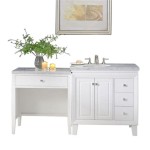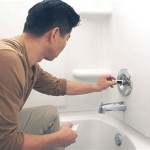Can We Use Marble In Bathrooms? A Comprehensive Guide
Marble, a metamorphic rock derived from limestone, has been prized for its aesthetic qualities and durability for centuries. Its distinctive veining, varied color palette, and smooth, cool surface make it a desirable material for interior design, particularly in bathrooms. However, the suitability of marble in a bathroom environment is a complex issue, requiring careful consideration of its properties, potential drawbacks, and appropriate maintenance strategies.
The inherent elegance and perceived luxury of marble contribute significantly to its appeal in bathroom design. It can be used for a variety of applications, including countertops, flooring, wall cladding, shower surrounds, and even decorative accents. The natural variations in each slab of marble ensure a unique and visually appealing result, differentiating it from synthetic alternatives. The coolness of the stone is also beneficial, offering a refreshing tactile experience, especially in warmer climates.
Despite its aesthetic advantages, marble is not without its limitations in a bathroom setting. The high humidity, fluctuating temperatures, and frequent exposure to water and cleaning products pose specific challenges that must be addressed to ensure the longevity and beauty of the material. Understanding these challenges is crucial for making an informed decision about incorporating marble into bathroom design.
Key Point 1: Understanding Marble's Porosity and Susceptibility to Staining
A primary consideration when deciding whether to use marble in a bathroom is its porosity. Marble is a relatively porous material, meaning it has small spaces within its structure that can absorb liquids. This inherent porosity makes it susceptible to staining from spills, such as soaps, shampoos, cosmetics, and even hard water. The severity of staining depends on the type of liquid, the duration of exposure, and the color of the marble itself. Lighter-colored marbles, such as Carrara or Calacatta, are generally more susceptible to staining than darker varieties.
Furthermore, marble is vulnerable to etching, a chemical reaction that occurs when acidic substances come into contact with the calcium carbonate that comprises the stone. Common household products like vinegar, lemon juice, and certain cleaning agents can cause etching, leaving dull, white marks on the surface. These etches are not stains, but rather a physical alteration of the marble's finish, often requiring professional polishing to restore the original luster.
To mitigate the risk of staining and etching, proper sealing is essential. Applying a high-quality penetrating sealant creates a barrier that reduces the absorption of liquids into the marble. Sealants should be applied regularly, typically every six to twelve months, depending on the frequency of use and the type of sealant used. Choosing pH-neutral cleaning products specifically designed for natural stone is also crucial to prevent etching and maintain the integrity of the marble surface.
The use of mats and trays in areas prone to spills, such as around sinks and in showers, can further protect the marble from direct exposure to potentially damaging substances. Promptly cleaning up spills is also paramount to prevent staining and etching. Regular wiping and dusting can prevent the buildup of dirt and grime that can exacerbate these issues.
Key Point 2: Addressing Slip Resistance and Water Damage Concerns
Another important consideration is the slip resistance of marble flooring, particularly in wet environments like bathrooms. Polished marble, while aesthetically pleasing, can become slippery when wet, posing a safety hazard. To address this concern, textured or honed marble finishes are often recommended for bathroom floors. These finishes provide a slightly rougher surface that increases traction and reduces the risk of slipping.
Another option is to use smaller marble tiles with wider grout lines. The grout lines act as a form of slip resistance, providing additional grip. Area rugs and bath mats can also be strategically placed in high-traffic areas to improve safety and prevent slips.
Water damage is another potential concern. Prolonged exposure to moisture can lead to water stains, discoloration, and even structural damage over time. Proper ventilation is crucial for minimizing humidity levels in the bathroom. Installing a powerful exhaust fan and ensuring adequate airflow can help to prevent moisture buildup and protect the marble from water damage. Carefully sealing grout lines is also essential to prevent water from seeping behind the tiles and causing damage to the substrate.
Regular inspections are recommended to identify and address any signs of water damage promptly. Look for discoloration, staining, or loose tiles, and address any issues immediately to prevent further degradation of the marble.
Key Point 3: Selecting the Right Type of Marble and Ensuring Proper Installation
The type of marble chosen for a bathroom significantly impacts its performance and longevity. Some varieties of marble are denser and less porous than others, making them more suitable for wet environments. Carrara marble, for example, is a popular choice for its relatively low cost and availability, but it is also more porous than some other varieties. Calacatta marble, known for its striking veining and luxurious appearance, is slightly less porous and often considered a more durable option. Other marbles, such as Nero Marquina (black marble) and Crema Marfil (beige marble), offer different aesthetic qualities and varying degrees of porosity.
The quality of the installation is just as important as the type of marble used. Proper installation ensures that the marble is properly sealed, supported, and protected from moisture damage. A professional installer will have the experience and expertise to assess the substrate, select the appropriate adhesives and sealants, and ensure that the marble is installed correctly.
The substrate, the surface beneath the marble, must be level, stable, and properly prepared to prevent cracking and shifting of the marble tiles. A waterproof membrane should be installed between the substrate and the marble to prevent moisture from penetrating the structure. The installer should also ensure that the grout lines are properly sealed to prevent water from seeping behind the tiles.
Furthermore, proper installation includes the use of expansion joints to accommodate the natural expansion and contraction of the marble due to temperature and humidity fluctuations. These joints prevent the marble from cracking or buckling under stress. Careful planning and attention to detail during the installation process are crucial for ensuring the long-term performance and beauty of marble in a bathroom.
In addition to selecting the right marble type and ensuring proper installation, proactive maintenance is paramount. Even with the best sealing and installation, marble requires regular cleaning and care to maintain its pristine appearance. Regular cleaning with pH-neutral cleaners, prompt spill cleanup, and periodic resealing are essential for preserving the beauty and longevity of marble in a bathroom environment. Ignoring these maintenance requirements can lead to staining, etching, and other forms of damage that can diminish the aesthetic appeal and structural integrity of the marble.
The decision to use marble in a bathroom is therefore a multifaceted one, requiring careful consideration of its inherent properties, potential drawbacks, and the commitment to ongoing maintenance. When properly selected, installed, and maintained, marble can provide a luxurious and enduring finish to a bathroom. However, neglecting these factors can lead to costly repairs and a disappointing outcome. A thorough understanding of the challenges and solutions outlined above is crucial for making an informed decision and maximizing the beauty and longevity of marble in a bathroom setting.

Want To Use Marble In Your Bathroom Here S The Guide You Ve Been Looking For Hipcouch Complete Interiors Furniture

Pros And Cons Of Marble In The Bathroom

5 Amazing Uses Of Marble In Bathrooms And Kitchens

Pros And Cons Of Marble In The Bathroom

Do We Regret Using Marble Tile In Our Shower Erin Kestenbaum

How To Use Marble In Your Bathroom Bathrooms Designs The Showroom

5 Reasons Marble Is A Great Choice For The Bathroom Granite Gold

5 Modern Ways To Use Marble In Your Bathroom Best Cheer Stone

The Best Ways To Introduce Marble Into Your Bathroom Big

Why Marble Might Be Wrong For Your Bathroom
Related Posts







